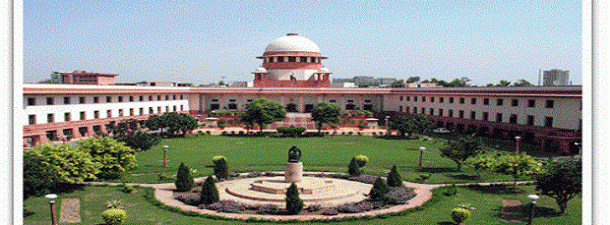India witnessed yet another unprecedented move last week. Top four judges of the Supreme Court held a press conference thus exposing an unparalleled dissention in the top echelons of the judiciary.
The move is being seen as a banner of revolt against the Chief Justice Deepak Mishra. The matter at its heart is an administrative issue—of allocation of cases to different benches—and has been  brewing over several months. The aggrieved judges—Jasti Chelameswar, Ranjan Gogoi, Madan B. Lokur, Kurian Joseph—feel that CJI Dipak Misra has been ignoring the senior judges of the court while allocating important and high profile cases. The issue is also political in nature as the chief justice in now facing allegation that he has been handing over cases that were sensitive to the ruling government to junior judges in the Supreme Court specially to Justice Arun Mishra who is “known” to be close to the ruling Bharitya Janta Party (BJP). Soon another chapter opened up that further confirmed that all must not be right in the highest judicial corridors of India. Three retired judges of high court and a former Supreme Court judge wrote an open letter to Chief Justice of India Dipak Misra, though they urged the Chief Justice to take “immediate steps” to resolve the crisis. Their letter had a direct reference to what could have been wrong in the Indian system of judiciary. In their letter, Justices P B Sawant (former SC Judge), A P Shah (former Chief Justice of Delhi High Court), K Chandru (former judge of Madras High Court), and H Suresh (former judge of Bombay High Court) wrote: “We agree with the four Judges that though the Chief Justice of India is the master of roster and can designate benches for allocation of work, this does not mean that it can be done in an arbitrary manner such that, sensitive and important cases are sent to hand-picked benches of junior judges by the Chief Justice. They also said that “clear rules and norms” must be laid down for allocation and distribution of cases, which are “rational, fair and transparent”.
brewing over several months. The aggrieved judges—Jasti Chelameswar, Ranjan Gogoi, Madan B. Lokur, Kurian Joseph—feel that CJI Dipak Misra has been ignoring the senior judges of the court while allocating important and high profile cases. The issue is also political in nature as the chief justice in now facing allegation that he has been handing over cases that were sensitive to the ruling government to junior judges in the Supreme Court specially to Justice Arun Mishra who is “known” to be close to the ruling Bharitya Janta Party (BJP). Soon another chapter opened up that further confirmed that all must not be right in the highest judicial corridors of India. Three retired judges of high court and a former Supreme Court judge wrote an open letter to Chief Justice of India Dipak Misra, though they urged the Chief Justice to take “immediate steps” to resolve the crisis. Their letter had a direct reference to what could have been wrong in the Indian system of judiciary. In their letter, Justices P B Sawant (former SC Judge), A P Shah (former Chief Justice of Delhi High Court), K Chandru (former judge of Madras High Court), and H Suresh (former judge of Bombay High Court) wrote: “We agree with the four Judges that though the Chief Justice of India is the master of roster and can designate benches for allocation of work, this does not mean that it can be done in an arbitrary manner such that, sensitive and important cases are sent to hand-picked benches of junior judges by the Chief Justice. They also said that “clear rules and norms” must be laid down for allocation and distribution of cases, which are “rational, fair and transparent”.
The tipping point for the Judges seems to be the case of special CBI Judge Loya. Two petitions demanding a thorough probe into his mysterious death were listed before a bench headed by a judge who is tenth in seniority. The petitions are asking for an enquiry into events and circumstances surrounding the death of Judge Loya in light of news reports. The Public Interest Litigation (PIL) mentions the chronology of the deaths of Sohrabuddin, his wife Kausar Bi and his aide Tulsiram Prajapati; the transfer of Judge J.T. Utpat, appointment of Judge Loya to his post. The PIL then quotes an article dated November 21 2017, in the Caravan magazine on Judge Loya’s sister questioning her brother’s death. The plea also points out how, Judge Loya had confided to his sister that he was offered a bribe of Rs 100 crore in return of a favorable judgment. It also mentions that how the then Home Minister of Gujarat got exonerated in the very next hearing held by the succeeding judge after the death of Judge Loya. The case does have a merit to he heard, especially when the son of Judge Loya has come out to say that the family no longer has any suspicion to the events leading to the death of his father. He could have been pressurized to say so by those who can, can’t be ruled out. Other flash points to the controversy are Medical Council of India bribery case that was heard by the Chief Justice of India Deepak Mishra himself despite having been warned by fellow judges of a conflict of interest, the manual of procedure for allocating cases and arbitrary constitution of benches. These issues are those which are visible at the surface, what lies beneath could be more serious question and the attribution of more sinister motives. For many the courage shown by the four judges was an attempt to get just one of the institutions out of cudgels of the government.
In the words of these four wise judges, “It is a discharge of a debt to the nation,” and “We have heard lot of wise men saying a lot of things in this country. We don’t want some very wise men 20 years later to blame that Justice Chelameswar, Gogoi, Lokur and Kurian Joseph sold their souls and that they take care of the institution and didn’t do the right thing,” will keep on echoing in India for some more time. Consider this. Had those four judges not spoken up, one of them would have been Chief Justice in next six months. Three of them would have retired this year and could have grabbed cushy appointments post retirement and enjoyed perks and favors. The judges must have drawn enough courage to speak!







No Comments
Comments for Putting a lot at stake, they speak! are now closed.